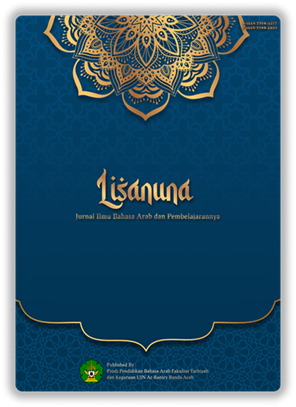تطوير مهارة الترجمة من اللغة العربية إلى الإندونيسية لدى طلاب جامعة الرانيري الإسلامية الحكومية
DOI:
https://doi.org/10.22373/ls.v14i1.22702Keywords:
Development, Translation Skill, Arabic Language, Student, Language SenseAbstract
Artikel ini ingin membahas tentang bagaimana upaya peningkatan kemampuan dan keterampilan menerjemahkan teks Arab ke dalam bahasa Indonesia di kalangan mahasiswa Universitas Islam Negeri (UIN) Ar-Raniry Banda Aceh, khususnya mahasiswa Fakultas Tarbiyah Program Studi Pendidikan Bahasa Arab. Keterampilan menerjemahkan sebagaimana dipahami merupakan sarana terpenting dalam menjalin komunikasi dan menyampaikan pesan antarmanusia, juga sarana untuk saling mengenal budaya, bahasa, dan pemikiran yang sangat penting bagi kehidupan manusia. Sayangnya, sebagian besar mahasiswa Program Studi Pendidikan Bahasa Arab masih menghadapi kesulitan besar dalam mempraktikkan keterampilan menerjemahkan teks Arab ke dalam bahasa Indonesia, sehingga mendorong artikel ini untuk mendiagnosis penyebabnya sekaligus mencari solusi untuk mengatasi kendala keterbatasan tersebut. Artikel ini merupakan artikel kualitatif, deskriptif analisis melalui observasi dan studi pustaka, dengan memaparkan permasalahan yang dihadapi dan mencari solusi sebagai jalan keluar dari permasalahan penerapan keterampilan menerjemahkan teks Arab ke dalam bahasa Indonesia di kalangan mahasiswa Program Studi Pendidikan Bahasa Arab sebagai temuan penting dan simpulan akhir artikel ini.
Downloads
References
المراجع
إبتسام غانم. (2018). "حل المشكلات: إستيراتيجية تدريس فعالة لتطوير مهارات اللغة لدى المتعلمين". الطموحات. 1(2)، 1-14. http://journal.uir.ac.id/index.php/THUMUHAT
ابن منظور، جمال الدين محمد بن مكرم (ت 711 هـ). (1990). لسان العرب. (بيروت: دار صادر).
الزبيدي، محمد بن محمد مرتضى (ت 1205 هـ). (1972). تاج العروس من جواهر القاموس. (تحقيق إبراهيم الترزي). (الكويت: وزارة الإعلام).
سيف الله أزهري، محمد نعمان، ميمي جميلة، نور ألفين نافذة الرفقية، ميرنا لكباتون. (2022). "الدراسة المقارنة من اللغة العربية إلى اللغة الإندونيسية". مقال مقدم للملتقى العلمي الوطني قسم تعليم اللغة العربية.
لويس معلوف. (2005). المنجد في اللغة والأعلام. (بيروت: المطبعة الكاثوليكية، الحادية والأربعون).
مجمع اللغة العربية. (1960). المعجم الوسيط. (القاهرة: مجمع اللغة العربية).
Andri Ilham, Samsi Setiadi, Chakam Failasuf. (2022). “Need Analysis to Develop Arabic-Indonesian Translation Learning Model Based on Eco-Translatology Perspective”. ALSUNIYAT: Jurnal Penelitian Bahasa, Sastra, dan Budaya Arab, 5(1), 1-12, http://doi.org/10.17509/alsuniyat.v5i1.40594
Iryna Kobyakova, Svitlana Shvachko. (2016). “Teaching Translation: Objectives and Methods”. Advanced Education, 5, 9-13. DOI: 10.20535/2410-8286.61029
Jamal Mohamed Giaber. (2018). “An Integrated Approach to Teaching Translation Practice: Teacher’s Approach and Students’ Evaluation”. The Interpreter and Translator Trainer, 12(3), 275-281. https://doi.org/10.1080/1750399X.2018.1502006
Majdi Haji Ibrahim & Akmal Khuzairy Abd. Rahman. (2018). “Teaching of Arabic in Malaysia”. Intellectual Discourse, 26(1), 189–206. https://doi.org/10.31436/id.v26i1.1120
Meijuan Zhao. (2023). “Teaching Translation: Challenges and Strategies”. Studies in Linguistics and Literature. 7(3). 59-64. http://dx.doi.org/10.22158/sll.v7n3p59
Mohammad Adil. (2020). “Exploring the Role of Translation in Communicative Language Teaching or the Communicative Approach”. SAGE Open, 10(2), https://doi.org/10.1177/2158244020924403
Olivia Ananda Fitrah, Rusydi Baya’gub, Ali Muhsin. (2023). “The Effectiveness of Teaching Simultaneous Translation from Indonesian into Arabic in Improving Students’ Speaking Skills”, ARKHAS: Journal of Arabic Language Teaching, 3(2), 117-124. https://doi.org/https://doi.org/10.35719/arkhas.v3i2.1862
Salman Al Farisi, Syahminan, Fadhilah. (2020). “Shu’ubat al-Thalabah fi al-Tarjamah min al-Lughah al-‘Arabiyyah ila al-Lughah al-Indunisiyyah”. Lisanuna, 10(3), 592-603.
Sudi Yahya, Nur Hasaniyah, Murdiono, Akmaluddin. (2023). “Teaching Methods, Challenges, And Strategies for Improving Students’ Arabic Linguistic Competence”. Ijaz Arabi: Journal of Arabic Learning, 6(3), 870-880. DOI:10.18860/ijazarabi.v6i3.23558
Syamsi Setiadi. (2019). “Development of Instructional Design Arabic-Indonesian Translation Based On Collaborative Learning”. Arabiyat, 6(2), 238-253, http://dx.doi.org/10.15408/a.v6i2.12311
Downloads
Published
Issue
Section
License
1. Proposed Policy for Journals That Offer Open Access Authors who publish with this journal agree to the following terms:
1.a. Authors retain copyright and grant the journal right of first publication with the work simultaneously licensed under a Creative Commons Attribution License that allows others to share the work with an acknowledgement of the work's authorship and initial publication in this journal.
1.b. Authors are able to enter into separate, additional contractual arrangements for the non-exclusive distribution of the journal's published version of the work (e.g., post it to an institutional repository or publish it in a book), with an acknowledgement of its initial publication in this journal.
1.c. Authors are permitted and encouraged to post their work online (e.g., in institutional repositories or on their website) prior to and during the submission process, as it can lead to productive exchanges, as well as earlier and greater citation of published work (See The Effect of Open Access).
2. Proposed Policy for Journals That Offer Delayed Open Access Authors who publish with this journal agree to the following terms:
2.a. Authors retain copyright and grant the journal right of first publication, with the work [SPECIFY PERIOD OF TIME] after publication simultaneously licensed under a Creative Commons Attribution License that allows others to share the work with an acknowledgement of the work's authorship and initial publication in this journal.
2.b. Authors are able to enter into separate, additional contractual arrangements for the non-exclusive distribution of the journal's published version of the work (e.g., post it to an institutional repository or publish it in a book), with an acknowledgement of its initial publication in this journal.
2.c. Authors are permitted and encouraged to post their work online (e.g., in institutional repositories or on their website) prior to and during the submission process, as it can lead to productive exchanges, as well as earlier and greater citation of published work (See The Effect of Open Access).

